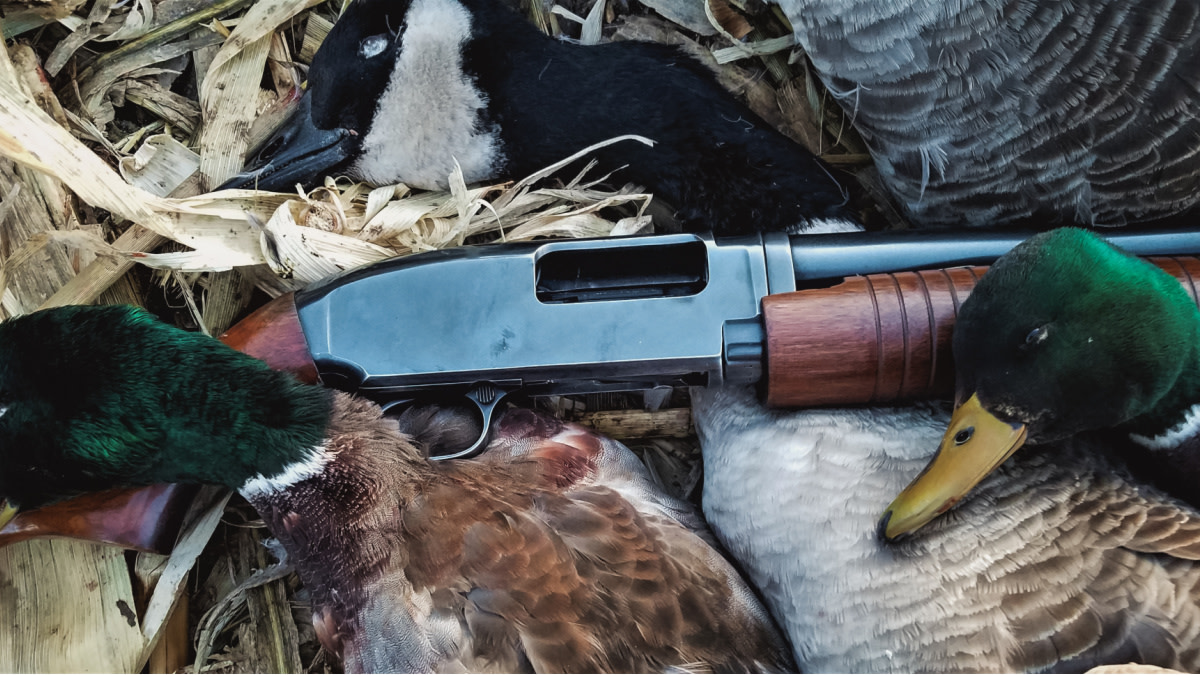
Our parents and grandparents hunted ducks and geese with walnut-stocked, fixed-choke shotguns without complaint. Those old guns keep you in touch with waterfowling’s past in a way that a plastic-stocked, camo gun never can. Hunting with older guns is like hunting with hand-carved decoys—it’s a little less practical, much more traditional, and every bit as effective.
You’ll have to wipe a blued gun down after a wet hunt and keep the stock away from metal pit frames, but the biggest adjustment to make is your choice of ammunition. Some of the guns lack 3-inch chambers, and many are made of steel that can’t withstand high-volume shooting with steel or tungsten-iron shot. You’ll need bismuth for those.
Here are a few old school guns you can still find and take to the duck blind. You’ll have to baby most of these with bismuth, but that will just make them shoot more like your dad’s gun did back in the days of lead.
Winchester Model 12
Considered by many to be the greatest pump gun ever made, the slick Model 12 was introduced in 1912 and made until 1964. Nearly 2,000,000 were produced, so it’s not a hard gun to find. Long before Tom Knapp and the Gould Brothers, Winchester pro shooter Herb Parsons would throw a stack of clay targets in the air, take advantage of the gun’s lack of a trigger disconnect, and pump out shots as fast he could work the slide.
Most 12-gauge Model 12s will have 2 ¾-inch chambers and 30-inch, full-choke, ribless barrels. There are a ton of those around at a reasonable price. It’s harder to find the 3-inch Heavy Duck model; a heftier, magnum gun that was the last word in waterfowl guns for years.
Browning Superposed
In the 1920s, John Browning imagined the Superposed as an over-under the average hunter and shooter could afford. He literally died while working on the gun, but his son Val was able to finish it. You had to save up for a Superposed, but many did. It became an aspirational gun, especially for the post-war generation of American shooters and hunters of the 50s and 60s.
Like other Browning guns of its era, the Superposed was made at the Herstal factory in Belgium. The guns are beautifully fit and finished, but its good looks don’t disqualify it from the duck blind. At around 8 pounds, the 12 gauges are a bit much to carry in the uplands, but are great for waterfowling where the weight helps absorb recoil and smooths your swing. Even better, the market for the 12-gauge Superposed is soft, and they don’t command the prices of the 20s. You can find one for less than the price of a new Super Black Eagle. Most Superposed guns have 2 ¾-inch chambers, but a few 3-inch guns were made as well.
Browning Auto 5
Although sometimes called an A5, the Browning Auto 5 is not to be confused with the modern A5. Dating back to the earliest days of the 20th century, the original Automatic 5 was the first semiautomatic shotgun. It operates on the long-recoil principle, in which the barrel and bolt move back together for the whole length of the shell. Another of John Browning’s inventions, the Auto 5 was so far ahead of its time and patent-protected that no competitor could make a practical semiauto for the next 50 years.
Made for nearly 100 years, first in Belgium, then in Japan beginning in the 70s, the Auto 5 was as reliable as it was distinctive with its square-backed receiver. It was made in standard and magnum versions in 12, 16, and 20 gauge. The Japanese guns are steel-friendly. However, if you buy a Belgian gun, you’ll either need bismuth ammo or a Japanese barrel for it.
Remington 870
You may consider the Remington 870 a gun that is simple and reliable, but it has been around for 70 years and was revolutionary in its day. Designed using pressed parts and common parts, the mass-produced 870 was as inexpensive as it was great. Built on the receiver of a 16-gauge 11-48 semiauto, the 12-gauge 870 was trim. It pointed well thanks also to a stock that seemed to fit every size and shape of hunter.
The guns came in magnum and standard models in 12, 16, and 20 gauge. All of them will shoot steel, bismuth, or anything else you want to run down the barrel. Remington says older, full-choked guns should shoot nothing larger than #2 steel.
Some believe (myself included) that the 870s of the last 15 years aren’t as good as the older guns. But that’s all the reason to look for an aged Wingmaster instead of a brand new one.










Conversation